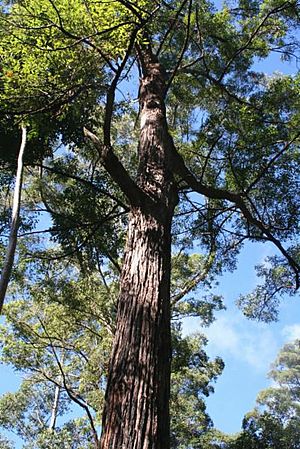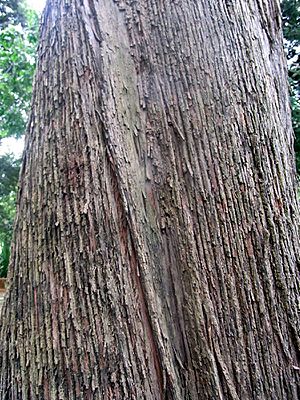Northern grey ironbark facts for kids
Quick facts for kids Northern grey ironbark |
|
|---|---|
 |
|
| Eucalyptus siderophloia at Mount Mellum | |
| Scientific classification | |
| Genus: |
Eucalyptus
|
| Species: |
siderophloia
|
The Northern Grey Ironbark (scientific name: Eucalyptus siderophloia) is a medium to tall tree found only in southeastern Australia. It's known for its tough, dark, grooved bark. This tree has long, curved leaves, white flowers, and fruit shaped like a cup or cone.
Contents
What Does the Northern Grey Ironbark Look Like?
The Northern Grey Ironbark usually grows to be about 20 to 45 meters (65 to 148 feet) tall. It has a special woody swelling at its base called a lignotuber. This helps the tree regrow if it's damaged by fire or cutting.
Its trunk and branches are covered in hard, rough, grey or black bark with deep grooves. Sometimes, the bark on thinner branches can be smooth.
Leaves and Flowers
Young plants and new shoots have egg-shaped to spear-shaped leaves. These leaves are lighter on their underside and measure about 50 to 120 mm (2 to 4.7 inches) long and 15 to 48 mm (0.6 to 1.9 inches) wide.
Adult leaves are the same shade of green on both sides. They are spear-shaped or curved, about 85 to 175 mm (3.3 to 6.9 inches) long and 15 to 30 mm (0.6 to 1.2 inches) wide. They narrow down to a leaf stalk, called a petiole, which is 10 to 25 mm (0.4 to 1 inch) long.
The tree's white flowers usually grow in groups of seven at the ends of its small branches. Each group of flowers is on a stalk called a peduncle, which is 5 to 12 mm (0.2 to 0.5 inches) long. Each individual flower bud sits on a tiny stalk called a pedicel, 2 to 8 mm (0.08 to 0.3 inches) long.
Mature flower buds look like diamonds or spindles. They are 5 to 10 mm (0.2 to 0.4 inches) long and 3 to 4 mm (0.1 to 0.2 inches) wide. Each bud has a cone-shaped cap, called an operculum, which falls off when the flower opens. The tree mostly flowers from September to January.
Fruit
After flowering, the tree produces woody, cup-shaped or cone-shaped fruits. These fruits are called capsules. They are 3 to 8 mm (0.1 to 0.3 inches) long and 4 to 7 mm (0.2 to 0.3 inches) wide. The parts that open to release the seeds are usually level with the rim of the fruit.
How Did It Get Its Name?
The scientific name Eucalyptus siderophloia was first officially written down in 1867 by a botanist named George Bentham. He included it in his book Flora Australiensis, which describes Australian plants.
The word "Terri-barri" is an Aboriginal word from the Sydney area. The scientific name siderophloia comes from two ancient Greek words. "Sidero" means "iron," and "phloia" means "bark." This name perfectly describes the tree's very hard, iron-like bark.
Where Does This Tree Grow?
The Northern Grey Ironbark grows in forests along the coast and in the nearby foothills. It prefers soils that are quite fertile. You can find this tree from places like Maryborough and Springsure in Queensland, all the way down to near Sydney in New South Wales.
What Is This Tree Used For?
The wood from the Northern Grey Ironbark is very strong and useful. The inner part of the wood, called sapwood, is usually safe from a type of beetle called the lyctus borer. This beetle can damage other types of timber.
Even though it's a bit hard to work with, the timber has a beautiful look, similar to some wood from rainforest trees. It's often used for:
- Flooring and decking (for outdoor areas)
- Shipbuilding
- Poles (like power poles)
- General construction
- Railway sleepers (the wooden beams under train tracks)
- Heavy engineering projects (where very strong wood is needed)


